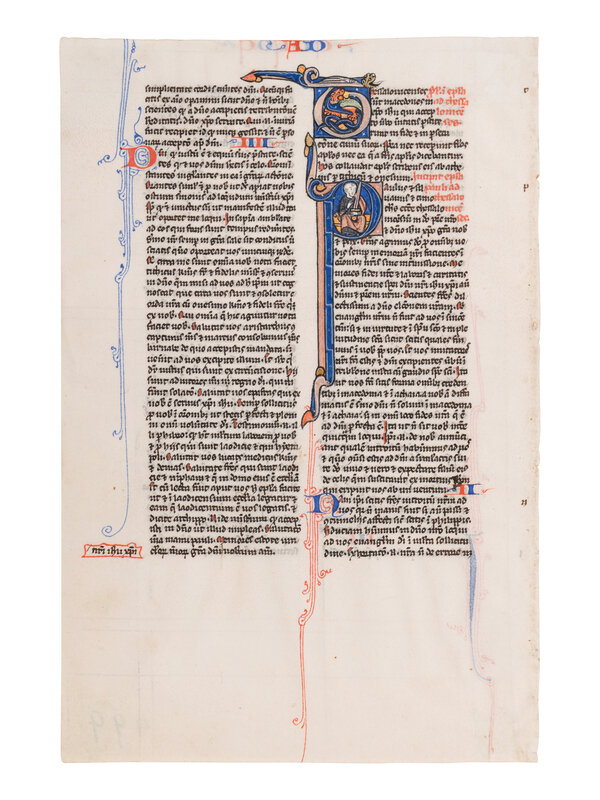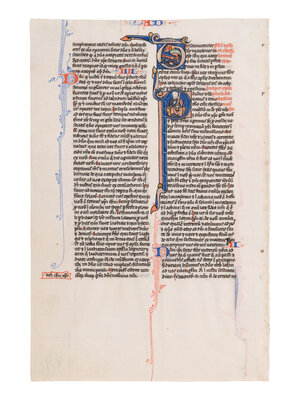JOHANNES GRUSCH ATELIER (active Paris, c. 1235-1260s)
A leaf from a Bible, with a historiated initial ‘P’ of St. Paul, in Latin, illuminated manuscript on parchment [Paris, c. 1250]
A leaf from a Bible, with a historiated initial ‘P’ of St. Paul, in Latin, illuminated manuscript on parchment [Paris, c. 1250]
Sale 2033 - Western Manuscripts and Miniatures
Jun 27, 2024
10:00AM CT
Live / Chicago
Own a similar item?
Estimate
$2,000 -
3,000
Price Realized
$2,032
Sold prices are inclusive of Buyer’s Premium
Lot Description
JOHANNES GRUSCH ATELIER (active Paris, c. 1235-1260s)
A leaf from a Bible, with a historiated initial ‘P’ of St. Paul, in Latin, illuminated manuscript on parchment [Paris, c. 1250]
A leaf from a Bible, with a historiated initial ‘P’ of St. Paul, in Latin, illuminated manuscript on parchment [Paris, c. 1250]
The roots of the modern Bible are found in the new portable Bibles, such as the parent manuscript of this leaf, that are one of the thirteenth century’s most striking inventions.
153 x 100 mm. Single leaf, ruled in plummet for two columns of 44 lines (written space: 100 x 68 mm), with an extra rule in the top margin for the running titles, vertical and double horizontal bounding lines ruled full across, written below top line in black ink in a formal gothic book hand, one marginal correction framed in red, versal initials touched with red, rubrics in red, running titles and chapter numbers alternately in red and blue, with instructions written by the scribe close to sewing edge for chapter numbers and initials, three two-line initials alternatively in red and blue with contrasting penwork extending into the top or lower margins, one five-line illuminated initial in light pink inhabited by a dragon on blue ground highlighted by white tracery, dots, and gold, ONE FIVE-LINE HISTORIATED INITIAL in blue with white tracery and dots, enclosed by light pink border highlighted by white tracery, dots, and gold, and terminated by leafy designs (pasted on card, else very good condition).
This leaf comes from a splendid thirteenth-century pocket Bible written in Paris in the mid-thirteenth century. This leaf contains the end of Colossians and beginning of 1 Thessalonians, reading on the recto from Colossians 2:4, “[ut nemo vos decipiat in sublimitate sermo]num,” to the usual prologue of I Thessalonians, “Thessalonicenses sunt macedones,” and I Thessalonians 2:3 on the verso, “Exhortatio enim nostra non de errore, neque….” The prologue to Thessalonians is introduced by an illuminated initial in light pink on blue ground inhabited by a dragon with blue intertwined body, orange head and legs, and green wings. I Thessalonians itself begins with a historiated initial of St. Paul, for “Paulus,” showing the saint seated upright on a golden bench and holding a sword.
The miniatures were initially identified by Christie’s as “one of the finest works of the Johannes Grusch atelier,” an attribution with which the Cleveland Museum of Art concurs for a sister leaf, (inv. 2001.74). Branner named this “paintshop” (his term) after the priest responsible of copying one of its Bibles in 1267 (Sarnen, Collegium, MS 16). Over a period of thirty years, many artists were associated with the workshop, and the style changed considerably, so that Branner divided it into early, middle, and late periods. The earliest work is a Missal made for Rouen Cathedral between 1235 and 1245 (Rouen, Bibliothèque municipale, MS Y-50271; see Branner, fig. 212). The figural style, seen here in our leaf, displays flat little figures with inked draperies, bodies with white heads with small features, such as short-bearded chins for the men and pursed mouths. The present miniature may fit with the manuscripts of the middle period.
Provenance
(1) Les Enluminures, Paris, acquired in February 1998 by:
(2) Robert McCarthy, London, MS BM 1826.
Parent manuscript
1. By the second half of the twentieth century, the parent manuscript still consisted of 586 leaves, lacking only the frontispiece and first leaves of Genesis, each with historiated initial, including fifty-nine large illuminated initials, many incorporating dragon hybrids, as well as seventy-eight historiated initials often with extensive leaf or dragon terminals.
2. Unidentified German owner in the sixteenth century (?), responsible for naming the books in upper margins of most books.
3. Sotheby’s, London, 10 July 1967, lot 82.
4. Christie’s, London, 25 November 1992, lot 9.
5. Most likely dismantled by Bruce P. Ferrini, Akron, OH (1949-2010).
Sister leaves
Sister leaves are to be found in several public collections, such as Cleveland Museum of Art, inv. 1999.123, inv. 2001.74; Northern Illinois University, ND3355.C655 1150a; and Figeac, Musée Champollion, inv. 03-24-1, 03-24-2 (for a complete list of sister leaves, see Kidd 2018).
LITERATURE
On the present leaves as well as their parent manuscript and sister leaves, published: Sotheby’s 10 July 1967, lot 82; Christie’s, 25 November 1992, lot 9; Peter Kidd, The McCarthy Collection, Vol. III, French Miniatures, London, 2018, no. 24g, pp. 98-102 (with further literature). Further literature, see also Robert Branner, Manuscript Painting in Paris during the Reign of Saint Louis, Berkeley, CA, 1977.
We are grateful to Peter Kidd for permission to quote from his catalogue for this entry. Freeman’s | Hindman thank Senior Consultant Sandra Hindman and Elliott Adam for their assistance in preparing this sale.
The Collection of Robert McCarthy
Condition Report
Contact Information

